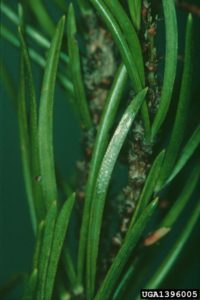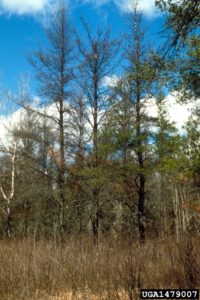By Todd Lanigan, forest health specialist, Eau Claire, Todd.Lanigan@wisconsin.gov, 715-210-0150.
No caterpillars or egg masses were found in the 2018 jack pine budworm surveys. Done in the spring for caterpillars and the fall for egg masses, surveys help predict jack pine budworm defoliation in the coming year. Surveys were conducted in the west central part of the state, covering portions of Dunn, Eau Claire, Jackson, Monroe, Pierce and St. Croix counties.

Caterpillars emerge in the spring and feed on host tree foliage.

Egg masses are deposited on the tips of host tree foliage.
In Wisconsin, jack pine budworm feeds on all native species of pine: jack, red and white. It is occasionally found on white spruce, but this has only been documented where spruce trees were located near an infested pine plantation.
Jack pine budworm regularly cycles from low to high populations, with outbreaks occurring every 8-10 years on average. During an outbreak, defoliation from these caterpillars can be widespread and lead to growth loss, topkill and tree mortality.

During a jack pine budworm outbreak, defoliation and mortality can be severe.
Wisconsin forests are overdue for an outbreak, with the last one occurring from 2005-2009, but annual surveys indicate that populations of jack pine budworm are still low enough to be undetected. Based on the 2018 surveys, jack pine budworm should not be a problem in 2019.
